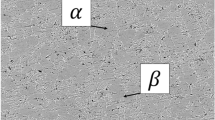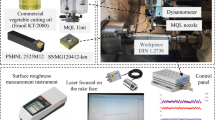Abstract
Machining of difficult-to-cut materials such as high-temperature metals is challenging due to their low machinability resulting in reduced productivity and high manufacturing cost. Turning is a common operation used for production of these parts where cutting speed, and thus the material removal rate, is limited due to high tool wear rate. Therefore, there is a need for alternative techniques in order to increase productivity in machining of these materials. This paper presents experimental results on two nonconventional turning operations, namely turn-milling and rotary turning processes, applied on common difficult-to-cut materials. Tool wear was measured under various cutting conditions for both processes and compared with conventional turning. From test results, it can be concluded that both turn-milling and rotary turning operations can provide longer tool life compared to conventional turning, thanks to intermittent characteristics of processes which result in lower average tool temperature. Effects of cutting and cooling conditions on tool life were also investigated yielding conclusions for selection of conditions for increased tool life.
Similar content being viewed by others
References
Ezugwu EO, Wang ZM (1995) Titanium alloys and their machinability—a review. J Mater Process Technol 68:262–274
Kappmeyer G, Hubig C, Hardy M, Witty M, Busch M (2012) Modern machining of advanced aerospace alloys—enabler for quality and performance. Procedia CIRP 1:28–43
Ezugwu EO (2005) Key improvements in the machining of difficult-to-cut aerospace superalloys. Int J Mach Tools Manuf 45:1353–1367
Machado AR, Wallbank J (1997) The effect of extremely low lubricant volumes in machining. Wear 210(1):76–82
Ezugwu EO, Bonney J (2004) Effect of high-pressure coolant supply when machining nickel-base, Inconel 718, alloy with coated carbide tools. J Mater Process Technol 153:1045–1050
Wang ZY, Rajurkar KP (2000) Cryogenic machining of hard-to-cut materials. Wear 239(2):168–175
Stephenson DA, Ali A (1992) Tool temperatures in interrupted metal cutting. J Eng Ind ASME 114:127–136
Schulz G, Spur G (1990) High speed turn-milling—a new precision manufacturing technology for the machining of rotationally symmetrical workpieces. CIRP Ann Manuf Technol 39(1):107–109
Choudhury SK, Mangrulkar KS (2000) Investigation of orthogonal turn-milling for the machining of rotationally symmetrical workpieces. J Mater Process Technol 99:120–128
Choudhury SK, Bajpai JB (2004) Investigation in orthogonal turn-milling towards better surface finish. J Mater Process Technol 170:487–493
Pogacnik M, Kopac J (2000) Dynamic stabilization of the turn-milling process by parameter optimization. Proc Inst Mech Eng B J Eng Manuf 214(2):127–135
Kopac J, Pogacnik M (1997) Theory and practice of achieving quality surface in turn milling. Int J Mach Tools Manuf 37(5):709–715
Neagu C, Gheorghe M, Dumitrescu A (2005) Fundamentals on face milling processing of straight shafts. J Mater Process Technol 166:337–344
Savas V, Ozay C (2007) Analysis of the surface roughness of tangential turn-milling for machining with end milling cutter. J Mater Process Technol 186:279–283
Filho JM (2012) Prediction of cutting forces in mill turning through process simulation using a five-axis machining center. Int J Adv Manuf Technol 58:71–80
Shaw MC, Smith PA, Cook NH (1952) The rotary cutting tool. Trans ASM 74:1065–1076
Armarego EJA, Karri V, Smith AJR (1994) Fundamental studies of driven and self-propelled rotary tool cutting processes-1: theoretical investigation. Int J Mach Tools Manuf 34(6):785–801
Armarego EJA, Karri V, Smith AJR (1994) Fundamental studies of driven and self-propelled rotary tool cutting processes-2: experimental investigation. Int J Mach Tools Manuf 34(6):803–815
Venuvinod PK, Lau WS, Narasimha R (1981) Some investigations into machining with driven rotary tools. J Eng Ind 103:469–477
Chen P (1992) High-performance machining of SiC whisker-reinforced aluminum composite by self-propelled rotary tools. Ann CIRP 41:59–62
Lei S, Liu W (2002) High-speed machining of titanium alloys using the driven rotary tools. Int J Mach Tools Manuf 42:653–661
Dessoly V, Melkote SN, Lescalier C (2004) Modeling and verification of cutting tool temperatures in rotary tool turning of hardened steel. Int J Mach Tools Manuf 44:1463–1470
Harun S, Shibasaka T, Moriwaki T (2009) Cutting temperature measurement in turning with actively driven rotary tool. Key Eng Mater 389:138–143
Sasahara H, Satake K, Nakajima H, Yamamoto H, Muraki T, Tsutsumi M (2008) High-speed rotary cutting of difficult-to-cut materials on multitasking lathe. Int J Mach Tools Manuf 48:841–850
Dmgmori (2014) NTX 2000-MAPPS Version. http://us.dmgmori.com/products/lathes/turn-mill-complete-machining-centers/ntx/ntx2000. Accessed 13 Aug 2014
Faverjon P, Rech J, Leroy R (2013) Influence of minimum quantity lubrication on friction coefficient and work-material adhesion during machining of cast aluminum with various cutting tool substrates made of polycrystalline diamond, high speed steel, and carbides. J Tribol 135(4):041602
Uysal E, Karaguzel U, Budak E, Bakkal M (2014) Investigating eccentricity effects in turn-milling operations. Procedia CIRP 14:176–181
Kayhan M, Budak E (2009) An experimental investigation of chatter effects on tool life. Proc Inst Mech Eng B J Eng Manuf 223(11):1455–1463
Author information
Authors and Affiliations
Corresponding author
Rights and permissions
About this article
Cite this article
Karaguzel, U., Olgun, U., Uysal, E. et al. Increasing tool life in machining of difficult-to-cut materials using nonconventional turning processes. Int J Adv Manuf Technol 77, 1993–2004 (2015). https://doi.org/10.1007/s00170-014-6588-7
Received:
Accepted:
Published:
Issue Date:
DOI: https://doi.org/10.1007/s00170-014-6588-7




